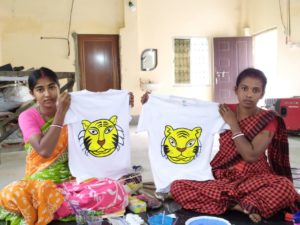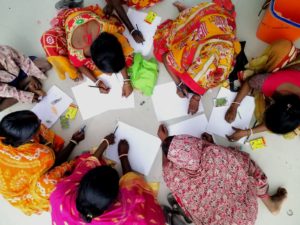“We were stunned when the kanthas handmade by the women of Sundarbans flew off our table at the exhibition organised by Namak Art Experience in Bengaluru this February,” a delighted Swarnali Chattopadhyay said over the telephone. She is the secretary of Kolkata-based Purono Kolkatar Golpo Society (PKG Society), an NGO.
Sundarbans mangrove forest lying along the southern edge of West Bengal is a UNESCO World Heritage Site.
“Many of the visitors were familiar with the ‘kantha stitch’ – kantha being the Bengali for quilts – but not the coverlet itself,” Chattopadhyay said.
When Namak Art contacted Bengaluru-resident Dipalika Banerjee Joshi, an admin at PKG Society if her organisation could help them showcase traditional art of Bengal, she jumped at the idea. Through their ‘Selaighar’ (selai in Bengali means stitch and ghar, house) project in the Sundarbans, they had been training women to make traditional quilts apart from other stitched products. Thus Chattopadhyay landed in Bengaluru one fine day in January carrying a bundle of quilts along with a range of handicrafts.
But the sale of the kantha in Bengaluru is not merely a tale of appreciation but an example of how non-government organisations are finding ways to revive traditional art forms while helping local women of the Sundarbans find an alternative way of income.
“The women would arrive to collect the provisions with their faces covered because they were ashamed of their sudden penury,” recalls Chattopadhyay, talking about their relief work in the mostly island-based habitations of the Sundarbans. The pandemic induced lockdown had already thrown life out of gear here and the super cyclone Amphan in 2020 made it worse. The local people, who were largely economically self-sufficient, suddenly found themselves at the mercy of others for daily sustenance. So the PKG Society group decided to help the families in different ways to earn a living. One of their most popular projects was Selaighor – tailoring training units for women. Here women were trained to be seamstresses in collaboration with Singer India. The successful ones received professional certificates after passing an examination.
While the women became adept at making different kinds of things, from blouses to bags, PKG Society decided to urge them to make the traditional quilts.
Once a popular household item, the kantha was an example of thrift practiced by Bengali women – recycling old saris to make coverlets; even the threads used to stitch and embroider were plucked from the saris. For most women, quilting was not only a means to economise on household spending but also a way to express their thoughts in an artistic manner. Today, many of the old quilts find a place of honour in museums across the world. However, largely owing to change in lifestyle and availability of cheap machine-made goods, kantha quilt making is almost a lost art. The Selaighor project gave the women an opportunity to revive it.
The most interesting thing about the handmade quilts is that each one is unique because the pattern or the embroidery is an outcome of the individual’s imagination. They make the quilts both from used saris and new ones. “We always inform the customer about what kind of sari has been used when they come to buy our kanthas,” says Banerjee Joshi.
Kolkata Society for Cultural Heritage (KSCH) too has been working in the Sundarbans where they have been implementing a series of projects for almost a decade. Some of their projects include increasing the mangrove cover through plantation methods , training residents to make paper plates [which can replace thermocol plates which harm the environment] and brown paper carry bags, installation of solar street lights and water treatment plants, etc.
KSCH has also been introducing projects which are geared towards income generation so that the people are not totally dependent on forest resources.
“But it is easier said than done because people in these rural areas are often sceptical of new/unfamiliar ideas,” says Sourav Mukherjee, a professional turned social entrepreneur, who left his secure job to launch Kolkata Society for Cultural Heritage to promote sustainable development.
“Meanwhile, our research into local life and culture revealed that the region was once known for its patachitra (scroll painting) art. But it has become almost extinct. So we decided to revive the art,” said Mukherjee.
However, they not only found it difficult to trace artists who practised the art but also potential beneficiaries were not very convinced that it was a viable way for making a living.
But they decided to give it a try anyway.
They organised a sit and draw competition for the women of the households. There was a fair response and the best among them were chosen for training. Nearly 40 women received training in patachitra art at a space provided by the state forest department in the Pakhirala Island.
“It was not easy for many of the women to attend the training,” recalls Mukherjee, “Some would come from faraway islands, travelling for over two hours by boats; some would even bring their children with them because there was no one to look after them at home.” But the interest shown by these women to learn a forgotten craft was what impressed the Sundarban Tiger Project (STR) officials and KSCH. Many had never picked up a paint brush before but they were eager learners.
An exhibition cum sale of the products made by the trainees was arranged in a hall attached to the STR’s office in Sajnekhali Island in January this year. “We realised there may not be many takers for the scrolls; so we decided to translate the art form into various utility products such as bookmarks, posters, coasters, bags, T-shirts, kettles, etc.” Mukherjee says. Many of the artists had drawn upon their surroundings as inspiration – tigers, crocodiles, deer, local trees. Ritualistic alpana were used to decorate the artefacts. To the delight of the exhibitors, many of the boat loads of tourists arriving at the island readily bought the products as souvenirs.
According to the organisers, a part of the earnings from the sale were set aside to buy raw material while the rest were distributed among the exhibitors.
To ensure that more women can be brought under the training umbrella, KSCH plans to hold more such workshops in the area. Initially they are also helping in the marketing of the products. As of now, visitors to Kolkata can find the products at the Zero Store run by the New Town Kolkata Development Authority (NKDA) in the eastern neighbourhood of Kolkata. The products are also expected to be available soon at the stores run by the forest department in the Sundarbans.



